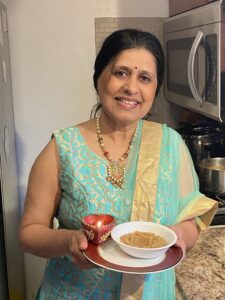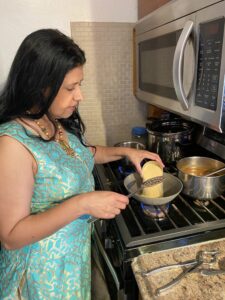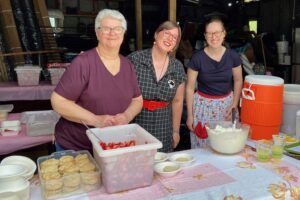
Diwali, the Hindu Festival of lights is round the corner. This five-day festival is possibly the most celebrated of all Hindu festivals, also shared by followers of Jainism, Sikhism and Buddhism. It is celebrated according to the Lunar calendar that Hindus follow, from the 13th day of the Ashvin month to the 2nd day of the Kartikka month. This year, Diwali will be celebrated from November 2nd to the 5th. The word, Diwali is derived from the Sanskrit work, Dipavali, which means a row of lights. One of the main highlights of the celebration is the lighting of lamps (“diyas”), lanterns, sparklers, and fireworks. Traditionally, everyone wears new clothes, makes special sweets and families visit each other dressed in all their finery, to exchange these sweets and good wishes.
In preparation, several days before the festival, homes get cleaned thoroughly for ‘Diwali cleaning,’ akin to spring cleaning. The five days start with ‘Dhanteras’ when homes are cleaned and kept ready, people buy gold, and businesses end their calendar year by placing their ledgers in front of the idols of God. The next day is “Naraka Chaturdashi,” to commemorate the victory of Lord Krishna over the demon, Narakasura. The third day is the main day of the festival when Lakshmi, the goddess of wealth and prosperity is worshipped. It is believed that she enters our homes in the late hours of the evening, and all homes are lit up with bright lights and diyas to welcome her. The fourth day is the start of the New Year for Hindus who follow the Vikrama calendar and also is the day for Govardhan Pooja, to honor Lord Krishna. The last and final day is “Bhai Dooj,” to celebrate the bond between brothers and sisters, when sisters honor their brothers and pray for their longevity and wellbeing, with brothers giving gifts in return!
My friend, Neeta Sethi (nee Phadke), a nurse practitioner in the Department of Surgery at White Plains Hospital, has lived in Tarrytown for over two decades. She was born and raised in Mumbai, and like me, Diwali holds a very special significance to her, bringing back memories of growing up in Panvel, on the outskirts of Mumbai. Growing up with very little means, having two meals a day was sometimes a luxury. Getting good grades in school and having a full belly was the definition of happiness to her as a young girl. She grew up without having a single toy to play with, reminisces Neeta. Pots and pans, marbles, kites, a vibrant imagination and dreaming of making a better future for herself made up for the lack of toys. Her parents’ unconditional love and good friends more than compensated for all the shortcomings of a materialistic world. Her mother always said, “Money can buy you a good mattress but not a good night’s sleep.”

Once a year, for Diwali, Neeta would get some small gifts, something that she needed, not wanted. Some fireworks, a few Diwali sweets, a new dress, and sandals, mainly because she would have outgrown the existing ones. But in retrospect, Neeta realizes that these experiences were priceless lessons in teaching her true values. To Neeta, Diwali signifies victory of good over evil and the lights represent warmth, peace, and love. It is a time for self-awareness, to recognize and rectify our shortcomings, be grateful for what we have, let go of grudges, cleanse one’s mind and illuminate from inside out, she says.
One of the sweets her mother made for Diwali was Sooji Halwa, also called ‘Sheera,” one of the simplest and most delicious sweets made throughout India, usually for festivals or just as comfort food. Her mother also made it to celebrate something like Neeta’s excellent grades after an exam or at times, even as a surprise for breakfast, and so, to this day, this dish always brings back special memories. Without fail, the sight of Diwali lights and the smell of Sooji Halwa take her back to the streets of Panvel, says Neeta, as she shares this recipe with us.
Sooji Halwa:
- 1 cup Sooji (semolina or cream of wheat)
- 2/3 cup of sugar
- ½ cup ghee (clarified butter)
- 21/2 cups of water
- 10-12 cashew nuts, halved.
Heat the ghee in a thick bottomed pan, add cashews and semolina and roast on low heat for 5-7 minutes. Keep stirring constantly to roast sooji evenly. This is the most important step of the recipe. Soon, the ghee will be seen separating from the sooji. Then, add the water and sugar and mix thoroughly. Let it cook until all the water is absorbed, stirring every few minutes to break any lumps. Serve hot, although this is delicious even at room temperature, and stays fresh for a day or two. Enjoy. Happy Diwali, everyone!







Short and sweet article reminding your old memories with your family.
Wish you, Atharva and Vikas ,a very very Happy Deepawali and Prosperous New Year.
Nandkumar kaka, Alka, Arti, Prasad & all family members.
Diwali brings back fond memories in my life. This article is a candid representation of life in India. Those experiences just make a person stronger and the grit to succeed becomes prominent. Thanks for sharing !
I love how you made Neeta’s memories come alive to a person who is not of Indian heritage. Thanks for a great story!
I love how you wrote of my friend, Neeta’s memories, and made them come alive to someone who is not of Indian heritage.
When I came to the USA, as a single women, the only dessert, I could make was this , can’t fail recipe. It has many associated memories. Thanks for the memories, Neeta .
Good article on the festival of Diwali. Sheera is indeed a simple but delicious dish to make. Neeta’s profile shows how she learnt what is really important in life. Her choice of sheera versus a richer mithai shows she still values simplicity. Happy Diwali
Lovely preparations.. this delicious sheera will surely make diwali more enjoyable..
A very good write up on Diwali and on my good friend Neeta Sethi with her roots in India.